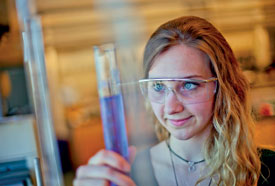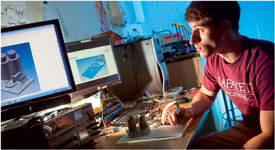Grounded in the Liberal Arts
By Kathleen Parrish | PHOTOGRAPHY BY ROY GROETHING
Knowing that he wanted to be a medical doctor was the reason Steven Shankman ’77 majored in English. “I enjoyed the readings in freshman English,” says Shankman, a prominent Brooklyn radiologist. “I knew I could major in anything and still go to med school.”
That’s not to say his future plans bore no influence on his liberal arts education. He wrote his senior honors thesis on Charles Dickens’ affinity for afflicting characters with disease symptoms. For example, did three ghosts really visit Ebenezer Scrooge on Christmas Eve or was the old man hallucinating from the consumption of poisonous mushrooms? And what about poor Tiny Tim? Had his father known about vitamin D deficiency, he could have used the money from Scrooge to buy the boy cod liver oil to help correct his deformed legs.
“I have found the ability to communicate very helpful and something lost on my trainees,” says Shankman, vice chairman of the radiology department and director of the residency program at Maimonides Medical Center. “We have a lot of bright, competitive students who majored in science, technology, engineering, or math, but they send me an email and I wonder if they know how to speak English.”
In a recent report by the Association of American Colleges and Universities, 93 percent of employers surveyed said, “a demonstrated capacity to think critically, communicate clearly, and solve complex problems is more important than [a candidate’s] undergraduate major.” In addition, more than 9 in 10 of those surveyed said it is important that those they hire demonstrate ethical judgment and integrity, intercultural skills, and the capacity for continued new learning, grounding provided by a liberal arts education.
These are important considerations as the technology-driven world continues to demand expertise in science and math and the need for STEM graduates continues to grow. President Obama affirmed his commitment to these fields by setting a goal of increasing graduates in them by 1 million by 2022, saying the competitiveness of our nation depends on it.
That’s a good start, notes President Alison Byerly, who adds that leading the world in innovation also requires the ability to apply cross-disciplinary thinking
to the complex problems of the day.
“Today’s students need to develop the capacity for open-ended inquiry cultivated by the liberal arts, and also the problem-solving skills associated with science and technology,” she wrote in a letter to The New York Times. “A quality curriculum does not shirk its responsibility to offer both.”
SCIENCE AND ART TOGETHER
A chemistry and art double major, Genna Asselin ’15 could be the poster child for that argument. She accepted a job after graduation as research development chemist at Kolmar Laboratories in Port Jervis, N.Y., which manufactures and packages cosmetics. “They were really excited about my art background,” she says, noting that attending a liberal arts school with strong STEM programs was the only decision she could have made and been happy.
“Science is my brain, and art is my sanity,” she says. “I couldn’t be without one of them. I would go insane.”
To meet Eamon Campolettano ’15, who graduated this year with a mechanical engineering major and economics minor, you’d never know he was once an introverted high-school kid who rarely mingled with his peers outside of class. Now well-spoken and confident with a broad grin and hearty handshake, Campolettano credits Lafayette’s broad-based education and its emphasis on writing well, thinking critically, and speaking with ease for bringing him out of his shell.

Science is my brain, and art is my sanity. I couldn’t be without one of them. I would go insane. ”
–Genna Asselin ’15
“I wasn’t very social in high school,” says Campolettano, who served as coordinator of the Landis Center’s after-school tutoring program at Easton Middle School, a resident adviser, and member of the Class of 2015 senior gift committee. “That was a transformation that happened when I got to college. At Lafayette, I was able to take on various leadership positions, and I developed into a more outgoing, visible leader.”
This fall, Campolettano heads to Virginia Tech where he’ll pursue a master’s in biomedicine. Having taken History of Architecture with Robert Mattison, Metzgar Professor of Art, and other humanities courses, Campolettano believes he will have an edge over his peers who earned degrees from technical schools.
“Graduates of liberal arts schools are in a strong position to lead the field because they can not only find unique ways to problem-solve, but they also understand how policy affects people. It’s a nice dual threat that has developed by combining liberal arts and engineering,” he says, noting the combination served him well during a recent audition for the TV trivia show Jeopardy. During the audition, he answered 50 questions on 50 topics ranging from the father of medicine to Western history to East Asian geography.
“They want to make sure you have a breadth of knowledge,” says Campolettano. “Being exposed to all kinds of things here really helped me out.” Whether it earns him a spot on the show remains to be seen.
A biochemistry major and McKelvy House resident, Todd Abrams ’79 credits having a well-rounded education for his career success. He received a Ph.D. in immunology from University of Pennsylvania before landing a faculty job at Allegheny University of the Health Sciences. When the medical school went bankrupt in 1998, Abrams decided to do something different and took a job as a writer at Meniscus Limited, a medical education and publishing company, where he was eventually named executive director of new product development and created training programs for nurses and pharmacists on the safe use of oncology drugs.
Today, Abrams is provost for research at Temple University, a position he says he never would have gotten without the ability to read a business plan, help companies find resources, and engage with people.

Eamon Campolettano ’15 developed an assistive device to help visually impaired people with handwriting.
“My Lafayette education gave me the groundwork and diversity of experience so I could think about things outside my major,” says Abrams, who played trumpet in the marching band and was a member of Kappa Sigma fraternity.
“I don’t think we’d be able to survive as a country and be as creative without the liberal arts,” he continues. “People call upon me to structure new programs and come up with new ideas. Reading literature and having knowledge of history and mathematics, you learn to solve problems using a multi-disciplinary perspective.”
EMPATHY AND LISTENING
Abrams’ sentiment was elegantly amplified by Jenn Stroud Rossmann, associate professor and head of mechanical engineering, in a column for Inside Higher Ed.
“History teaches us … that engineers focused solely on the technical and ‘useful’ will not yield better bridges, safer dams, or more elegant cellular phones,” she wrote. “At its core, engineering is about helping people live. Engineers can realize enormous benefits from rounding out their education… this will help them understand
and communicate with the people they hope to help.”
Two of the most important skills learned outside of her major are public speaking and writing, says Mary Higgins ’15, a biology major and math minor. As a sophomore, Higgins presented research she conducted with Robert Kurt, Kreider Professor of Biology, on cancer patients’ immune systems and behaviors of tumor cells at the Pennsylvania Academy of Science.
A Goldwater Scholar, Higgins will continue her research at the National Institutes of Health in Baltimore over the next two years.
“It’s very important to me to speak comfortably and communicate my science clearly so that people from a wide variety of backgrounds can understand,” she says. “It’s a good skill to have no matter what career you go into.”
STEM + Liberal Arts
The headline of a recent essay in The Washington Post reads: “We don’t need more STEM majors. We need more STEM majors with liberal arts training.” Indeed, medical schools are seeking applicants who have gone beyond the typical pre-med or biology degree, ones who have chosen to study English, art, history, anthropology, and philosophy in addition to core science courses.
“If American STEM grads are going to lead the world in innovation, then their science education cannot be divorced from the liberal arts,” writes Loretta Jackson-Hayes, associate professor of chemistry at Rhodes College.
The most recent revision of the Medical College Admissions Test is based on more than a decade of rethinking what makes a better physician. “Students need to have excellent knowledge in biology, chemistry, and physical sciences, but also in critical analysis and reasoning that applies to humanistic inquiry and the psychosocial basis of behavior,” says Nancy Waters, associate professor of biology and Lafayette’s health professions adviser. “The MCAT attempts to target those competencies and, by doing so, help to produce clinicians who are able not only to unravel detailed complex symptoms to diagnose a disease, but also to listen, observe, and synthesize information from their patients that sheds light on how the patient is suffering. They need communication skills honed to convey effectively the information critical to their patients’ well-being. They need to be respectful, resilient, and adaptable in how they approach alleviating distress, and they need to hold themselves and their team to high standards of ethical behavior and conduct.”
The Ichan School of Medicine at Mount Sinai has a program called HuMed, into which humanities students in top liberal arts schools are accepted after their second year of college. They continue to follow their nonscientific interests, and Mount Sinai teaches the science they need during the summers. Students in the program have early assurance of acceptance to the medical school.
David Muller, dean of medical education, said the program is based on the idea that you can’t be a good doctor—a well-rounded doctor who can relate to patients and communicate with them—unless you have had a good grounding in the liberal arts.